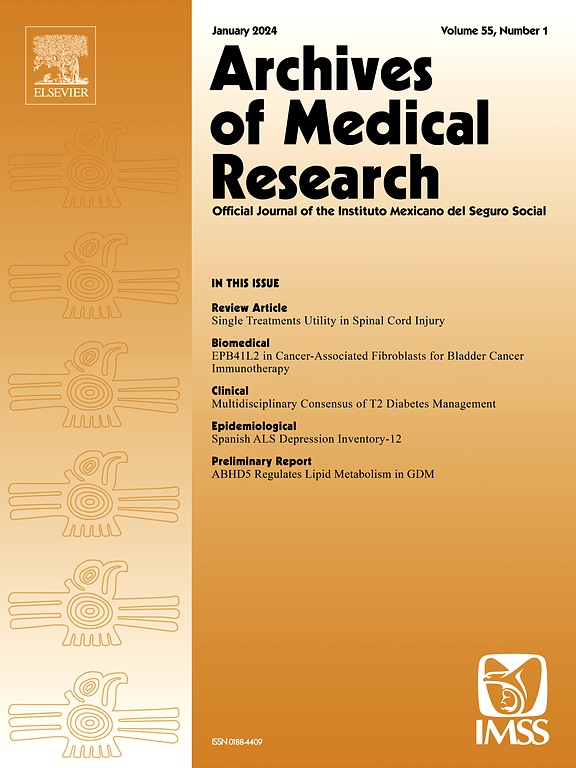Rivaroxaban Prophylaxis in Peripherally Inserted Central Catheter-Related Thrombosis in Breast Cancer Patients
IF 3.4
3区 医学
Q1 MEDICINE, RESEARCH & EXPERIMENTAL
引用次数: 0
Abstract
Objective
To evaluate the efficacy and safety of rivaroxaban in preventing catheter-related thrombosis (CRT) in breast cancer patients undergoing chemotherapy with peripherally inserted central catheters (PICC).
Methods
A prospective cohort study enrolled breast cancer patients who underwent PICC placement for chemotherapy at the San Huan Cancer Hospital from November 2021 to August 2023. The treatment group received 10 mg of oral rivaroxaban daily for 2 months along with routine grip strength training, while the control group received grip strength training only. CRT occurrence was confirmed by vascular ultrasound, and group comparisons were made using the χ2 test, with logistic regression analyzing CRT risk factors.
Results
Of 314 patients, 181 received treatment and 133 were in the control group. The treatment group had a significantly lower incidence of CRT (2.2 %, 4/181) compared to the control group (12.0 %, 16/133) (p < 0.001). Univariate analysis showed a higher risk of CRT in patients in the non-prophylaxis group (p = 0.002), patients aged ≥50 years (p = 0.014), and those with prior endocrine therapy (p = 0.030). Multivariate analysis identified rivaroxaban prophylaxis (p = 0.009) and age (p = 0.026) as independent risk factors for thrombosis. The use of rivaroxaban for prophylactic anticoagulation was safe. All CRT-diagnosed patients completed their antitumor therapy without new thrombosis or pulmonary embolism.
Conclusion
Two months of rivaroxaban prophylaxis effectively and safely reduce CRT incidence in breast cancer patients with PICC.
利伐沙班预防乳腺癌患者外周插入中心导管相关血栓形成
目的评价利伐沙班预防乳腺癌外周中心置管(PICC)化疗患者导管相关性血栓形成(CRT)的有效性和安全性。方法前瞻性队列研究纳入2021年11月至2023年8月在三环肿瘤医院接受PICC放置化疗的乳腺癌患者。治疗组每日口服利伐沙班10mg,疗程2个月,同时进行常规握力训练;对照组仅进行握力训练。经血管超声确认发生CRT,组间比较采用χ2检验,logistic回归分析CRT危险因素。结果314例患者中,治疗组181例,对照组133例。治疗组CRT发生率(2.2%,4/181)明显低于对照组(12.0%,16/133)(p <;0.001)。单因素分析显示,非预防组(p = 0.002)、年龄≥50岁组(p = 0.014)和既往接受内分泌治疗的患者(p = 0.030)发生CRT的风险较高。多因素分析发现利伐沙班预防(p = 0.009)和年龄(p = 0.026)是血栓形成的独立危险因素。利伐沙班用于预防性抗凝是安全的。所有经ct诊断的患者均完成了抗肿瘤治疗,无新的血栓形成或肺栓塞。结论利伐沙班预防治疗2个月可有效、安全地降低乳腺癌PICC患者的CRT发生率。
本文章由计算机程序翻译,如有差异,请以英文原文为准。
求助全文
约1分钟内获得全文
求助全文
来源期刊

Archives of Medical Research
医学-医学:研究与实验
CiteScore
12.50
自引率
0.00%
发文量
84
审稿时长
28 days
期刊介绍:
Archives of Medical Research serves as a platform for publishing original peer-reviewed medical research, aiming to bridge gaps created by medical specialization. The journal covers three main categories - biomedical, clinical, and epidemiological contributions, along with review articles and preliminary communications. With an international scope, it presents the study of diseases from diverse perspectives, offering the medical community original investigations ranging from molecular biology to clinical epidemiology in a single publication.
 求助内容:
求助内容: 应助结果提醒方式:
应助结果提醒方式:


